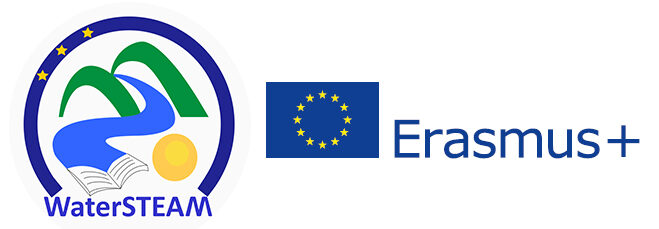WaterSTEAM methodology has been developed on the basis of the results of a survey (see the Methodology Guide) that was conducted at the beginning of the project among secondary education teachers and students of the partner schools, as well as specific stakeholder organizations, in Greece, Hungary, Italy and Turkey. The aim of the school survey is to define knowledge, skills, interests and attitudes in STEAM-related school subjects connected to the theme of the project: landscapes, water surfaces, global environmental issues. The stakeholders’ survey aimed to define their attitudes and interest towards being included as outside experts in the project.
The methodology is addressed to secondary school education and adopts an inquiry-based student-centred and interactive STEAM approach integrated with social and civic awareness, encouraging students to fully participate in social and civic life. WaterSTEAM methodology is based on Pedaste’s summary model of Inquiry Based Learning which identifies five phases: Orientation, Conceptualization, Investigation, Conclusion and Discussion.
The Methodology follows four main phases as described below (for details, look at the Methodology Guide).
PHASE 1. PREPARATION AND PLANNING
- Creation of an interdisciplinary team of teachers (teachers should be willing and keen to adopt the teaching methodology in own subject and to collaborate with other teachers)
- The team identifies a Coordinator who will be responsible for the development of the project and intra-team communications
- The team will identify the water landscape that students will work on.
- The team will set an interdisciplinary framework to identify different aspects that can be covered in different subjects.
PHASE 2. PRESENTATION OF THE WATERSTEAM PROJECT TO THE CLASS
PHASE 3. IMPLEMENTATION BY FOLLOWING AN INQUIRY BASED LEARNING APPROACH
- Orientation in a field trip or in the classroom regarding definitions of “landscape”, “landscape protection/management/ planning”, “landscape policy”, and learning activities on how we perceive landscape, what are the elements that make up a landscape, the E.L.C.
- Conceptualization on aspects of landscape that deserve investigation
- List and demonstration of ICT tools (Google Earth, SIFTR, LBG Apps, Excel, PPT)
- Investigation (e.g. field trip/lab/..) and data analysis
- Conclusions
- Discussion
Visit the page Learning Modules to apply the whole sequence of steps with the class.
PHASE 4. DEVELOPMENT OF A LOCATION BASED GAME
Location Based Games are games that can be played in a real environment on mobile devices and follow the steps of a fantasy story. Before starting to design a game, one should think about the following questions:
- What is the goal of your game?
- Is there a learning objective? How will you accomplish it?
- How many users and age groups will be involved?
- How long will the game last?
- What game mechanics will you use (points, scoreboards, escalation, narrative goals)
- Will your game require Wi-Fi/cellular coverage? Will you use QR codes instead?
Four main steps must be accomplished to develop a LBG:
- Choice of the Platform
- Storyboard elaboration
- LBG creation
- Promotion to the public
The list and demonstration of ICT tools (Google Earth, SIFTR, LBG Apps, Excel, PPT) is available as PDF in English
